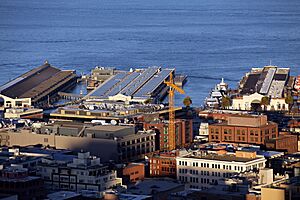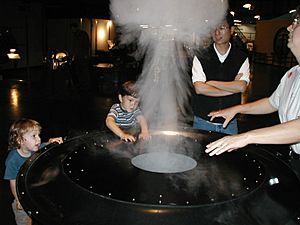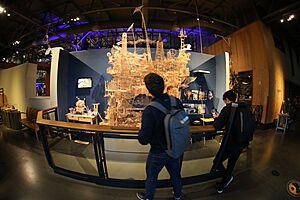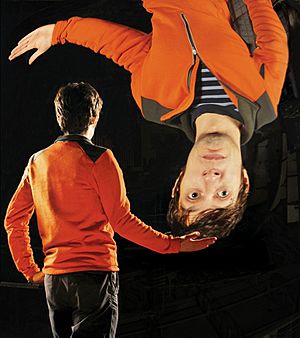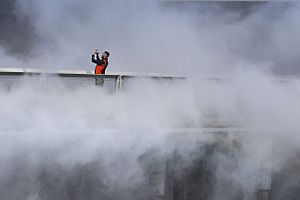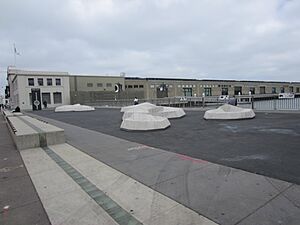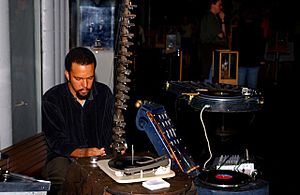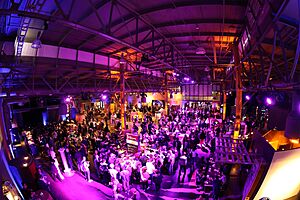Exploratorium facts for kids
 |
|
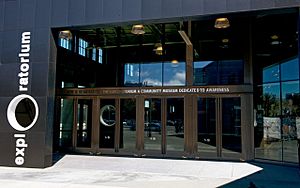
Main entrance to the Exploratorium at Pier 15
|
|
| Lua error in Module:Location_map at line 420: attempt to index field 'wikibase' (a nil value). | |
| Established | 1969; relocated in 2013 |
|---|---|
| Location | San Francisco, California, United States |
| Type | Science, art, and human perception |
| Accreditation | AAM, ASTC |
| Visitors | 1.1 million visits annually |
| Public transit access | The Embarcadero and Green station on the F Market & Wharves streetcar line; several other routes within walking distance |
The Exploratorium is a cool museum in San Francisco, California. It's all about science, technology, and art. A physicist and teacher named Frank Oppenheimer started it in 1969. The museum was first located in the Palace of Fine Arts. In 2013, it moved to Piers 15 and 17 on San Francisco's waterfront.
The Exploratorium has over 1,000 hands-on exhibits. These exhibits are grouped into different galleries based on their topics. Over the years, the Exploratorium has grown a lot. It has even inspired many other interactive museums around the world.
Contents
History of the Exploratorium
How the Exploratorium Started

The idea for the Exploratorium came from Frank Oppenheimer. He was a physicist and a university professor. Frank Oppenheimer had to leave his university job in 1949. After that, he ran a cattle ranch for almost ten years.
Later, he started helping high school students with their science projects. He even became the only science teacher at a high school in Pagosa Springs, Colorado. The fun, hands-on experiments he did with his students became the blueprint for the Exploratorium.
In 1959, Oppenheimer joined the University of Colorado's physics department. He became more interested in making people curious and helping them explore. He got a grant to build models of almost a hundred science experiments. These experiments became the main collection for the Exploratorium. They also led to the Exploratorium Cookbook, a guide on how to build these science exhibits.
Oppenheimer believed public museums were important for science learning. In 1965, he traveled through Europe to study museums. Three museums especially inspired him:
- The Palais de la Découverte in Paris, which used student helpers. This inspired the Exploratorium's famous High School Explainer Program.
- The South Kensington Museum of Science and Art in London.
- The Deutsches Museum in Munich, Germany, which had many interactive displays.
Back in the U.S., Oppenheimer decided to open his own museum in San Francisco. In 1967, he moved there to start his project. He asked scientists, businesses, and friends for help and money. Many important people supported his idea. With a $50,000 grant, the museum became a reality.
Original Home at the Palace of Fine Arts
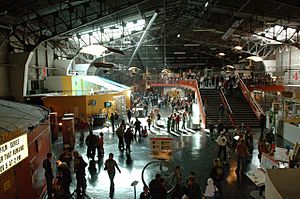
The Exploratorium opened quietly in August 1969 at the Palace of Fine Arts. Oppenheimer simply "opened the doors." The building needed work, but Oppenheimer wanted visitors to see exhibits being built. He wanted them to experience "the way a shop smells when you burn the wood in a saw." A sign above the workshop read: "Here Is Being Created the Exploratorium a Community Museum Dedicated to Awareness." A copy of this motto is now at the new Pier 15 entrance.
Oppenheimer was the museum's director until he passed away in 1985. Since then, the museum has grown a lot. It now reaches more people, helps more teachers, has a bigger website, and works with museums worldwide. Lindsay Bierman became the director in February 2022.
Moving to Piers 15 and 17
In April 2013, the Exploratorium moved from the Palace of Fine Arts. Its new home is at Piers 15 and 17. These piers are located along the San Francisco Embarcadero. The museum signed a 66-year lease for the piers. Exhibits are at Pier 15, while Pier 17 holds some staff offices.
Piers 15 and 17 are historic, built in 1931 and 1912. The area between them was once filled in and paved. This infill was removed during construction. Now, there are public plazas and open water between the piers again.
Building and Design
Renovating Piers 15 and 17
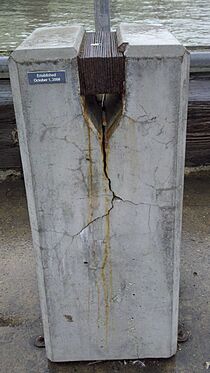
The Exploratorium's new campus has a huge amount of indoor and outdoor exhibit space. It also includes 1.5 acres of public space that anyone can visit for free. The exhibits are mainly inside and around Pier 15, which stretches over 800 feet into the Bay.
The architectural firm EHDD designed the Exploratorium at Pier 15. The piers were in rough shape before the museum moved in. A lot of renovation and repair work was needed. Many of the supports under Pier 15 were fixed or replaced. The old parking lot between the piers was removed slowly, and the materials were recycled.
Designers worked hard to keep the historic look of Pier 15. For example, old paint was removed from the east end of the pier, revealing historic lettering. This lettering from old shipping lines was kept. Some historic features, like windows, caused challenges for energy use. But solutions like special glass helped.
The building also has two seismic joints. These joints help the pier move safely during an earthquake. One joint separates the Bay Observatory from the rest of Pier 15. The other separates the entire pier from the land. This helps reduce stress on the building during a quake. The café inside the museum is even named "Seismic Joint" because it's located where one of these joints is.
Sustainability Efforts
The Exploratorium at Pier 15 aims to produce as much energy as it uses each year. This means it wants to be a "net-zero energy" building. The museum shows off its green efforts to teach visitors by example.
To reach its energy goal, the Exploratorium has many solar panels on its roof. There are 5,874 solar panels covering 78,712 square feet. They are expected to produce more energy than the building uses each year. Any extra energy goes back into the city's power grid.
The museum also uses water from the Bay to heat and cool the building. The Bay water is usually between 50 and 65 degrees Fahrenheit. This water is filtered and stored in a large tank. When needed, it goes through a heat exchanger to warm or cool water that flows through pipes in the floor. There are 27 miles of plastic tubing in the floor for heating and cooling! After use, the Bay water is returned to the Bay.
Using Bay water for cooling saves a lot of energy. It also saves millions of gallons of fresh water each year. The building also has special ventilation systems that bring in fresh air. This reduces the need for big, energy-hungry air conditioning systems.
The Exploratorium also works to save water. Two large tanks under the pier collect up to 338,000 gallons of rainwater and fog runoff. This water is reused in the building. The plumbing also helps save water, with special toilets and urinals.
Natural light is also used to save energy. The building has many windows and skylights. This lets in a lot of daylight, reducing the need for electric lights. In January 2014, the Exploratorium earned a top green building award called LEED Platinum certification.
Museum Layout and Exhibits
The new Exploratorium has over 600 exhibits. About 25% of these were made just for the Pier 15 location. Most exhibits are created right at the museum. The indoor and outdoor spaces are divided into six main galleries. Each gallery focuses on a different topic. Some exhibits can even move between galleries.
Exhibits cover many subjects. These include:
- How humans sense things (like sight, hearing, and learning).
- Life sciences (like plants and animals).
- Physical phenomena (like light, motion, electricity, and magnets).
- The local environment (like water, wind, fog, and Bay Area plants and animals).
- Human behavior (like how people cooperate or compete).
Gallery 1: Human Phenomenon
This gallery focuses on how people behave and perceive the world. Visitors can play with how they see things, explore memory and emotions, and experiment with cooperation. Some exhibits include:
- Poker Face: Partners try to guess when someone is bluffing.
- Trust Fountain: A two-person drinking fountain based on a classic trust game.
- Tactile Dome: A completely dark maze that visitors explore only by touch.
This gallery also has the Kanbar Forum. It's a theater that hosts music, science talks, and other events.
Gallery 2: Tinkering
Gallery 2 is a workshop area where visitors can build things with their hands. It's right across from the museum's own exhibit workshop, which visitors can also watch. Frank Oppenheimer wanted visitors to see how exhibits are made. Exhibits here encourage a "do-it-yourself" style. You can even make your own stop-motion films at Animation Stations.
Artworks in this gallery include:
- Tinkerer’s Clock: A 22-foot-tall clock with figures that visitors can move.
- Rolling Through The Bay: A sculpture made from over 100,000 toothpicks. It shows famous Bay Area landmarks, and a ping-pong ball can roll through it on different "tours."
Gallery 3: Seeing and Reflections
This gallery has many of the Exploratorium's "classic" exhibits. Some have been on display since the museum first opened. It mixes old and new exhibits that explore physics, light, color, and sound. Examples include:
- Sound Bite: Shows how you can hear with your jawbone instead of your ears.
- Bright Black: A trick that makes you think an object is white when it's mostly black.
Gallery 4: Living Systems
This gallery has many exhibits about life sciences. Many relate to the local Bay environment.
- Glass Settling Plate: Shows barnacles and other creatures growing in the Bay. You can watch them live under a microscope.
- Algae Chandelier: Visitors can pump air to help colorful tiny plants grow in overhead tanks.
Other exhibits explore different biological processes. These include looking at mouse stem cells and live chicken embryos.
Gallery 5: Outdoor Exhibits
This gallery is outside on Pier 15. It includes both areas you need a ticket for and public spaces. The focus is on interacting directly with the Bay environment.
- Color of Water: An art piece with 32 different colored fabric samples hanging below the pier. Visitors can see how the Bay's water changes colors.
- Remote Rains: This exhibit lets visitors choose a past rainstorm. A rain machine then recreates the storm's raindrops, letting you feel what the weather data means.
On the public bridge between Piers 15 and 17, artist Fujiko Nakaya created Fog Bridge #72494. It creates bursts of fog for six minutes every half-hour. This artwork helps visitors notice San Francisco's famous fog. It was supposed to be temporary but is now a permanent display.
Gallery 6: Observing Landscapes
The Bay Observatory building houses Gallery 6. It's the only new building on the campus. The lower level has the Seaglass restaurant. The upper level has exhibits about the waterfront and city. This gallery focuses on what visitors can see in real time. This includes clouds, tides, ships, and ocean data. The Observatory has glass walls on all sides for great views. Many exhibits were made just for this spot.
- Oculus: A circular opening in the ceiling that turns the whole gallery into a timepiece. It tracks seasons and the sun's movement.
- Visualizing the Bay: A 3-D map of the Bay Area. Visitors can see real data, like fog movement or Bay saltiness, mapped onto the landscape.
- Map Table: A collection of old and new maps showing different views of the area.
The Bay Observatory also has the Wired Pier project. This project uses sensors around the building to collect real-time data. It shows information about air quality, Bay water, weather, and tides. This data is then shown in interactive ways.
Public Spaces
The Exploratorium campus has 1.5 acres of public outdoor space. This includes the plaza facing the Embarcadero and the bridge between Piers 15 and 17. Some exhibits are in these public areas.
- Aeolian Harp: A large musical instrument played by the wind.
- Bay Windows: Visitors spin disks filled with mud, sand, and gravel from different parts of the Bay.
Educational Programs
The Exploratorium wants to make learning science fun and hands-on. It also trains teachers to use these methods. Thousands of teachers from many places have attended Exploratorium workshops.
Teacher Institute
The Teacher Institute started in 1984. It helps middle and high school science teachers. It offers workshops at the museum that teach hands-on, inquiry-based methods. It also supports new teachers. Studies show that teachers who go through this program are more likely to stay in teaching.
The Teacher Institute also hosts the Iron Science Teacher competition. This fun event is like the TV show Iron Chef. Science teachers create classroom activities using an everyday item. They compete for the title of "Iron Science Teacher."
Since moving to the Piers, the Exploratorium has expanded its teacher training. It also offers online courses for teachers. These courses help teachers bring engineering and hands-on activities into their classrooms.
Informal Learning Programs
The Exploratorium runs several programs focused on informal learning. The Institute for Inquiry (IFI) helps educators, scientists, and leaders improve science education. It provides workshops and online resources.
The Tinkering Studio started in 2008. It's a place in the museum where visitors can do hands-on "maker" activities. It also shares its ideas with educators in afterschool programs and other museums. The Tinkering Studio is inspiring similar programs around the world. The Exploratorium also partners with Boys and Girls Clubs to offer afterschool tinkering programs.
The Exploratorium has other learning resources too. The Learning Commons is a library for teachers. A webcast studio produces educational webcasts from the museum and other places. Lifelong Learning programs offer classes and workshops for kids, teens, families, and adults. The Exploratorium has also published many books and has thousands of hands-on activity ideas on its website.
Educational Outreach
The Exploratorium has programs to reach out to the community. The Community Outreach Program works with local groups. It provides educational activities for children and families who might not visit the museum otherwise. XTech is another program for middle school students. It offers afterschool science, engineering, and technology activities.
Explainers Program
The Exploratorium Explainer program has been running since the museum opened. It hires and trains high school students and young educators. After the move to Pier 15 in 2013, the program hired 300 Explainers. Explainers are like guides who help visitors learn.
There are two types of Explainers: High School Explainers (teenagers) and Field Trip Explainers (college students and young educators). Both are paid positions. Frank Oppenheimer started this program. He wanted young people to help visitors learn in an open-ended way. He felt they could better show that there are no "correct" answers, just exploration. He also wanted students to learn outside of school. Explainers come from many different backgrounds. Oppenheimer hoped they would bring their families and friends to the museum.
The Explainer Program was inspired by staff demonstrations Oppenheimer saw in Europe. The Exploratorium's program was so successful that other museums started similar programs. Many former Explainers say their time at the Exploratorium helped them succeed, including some famous tech CEOs.
Art at the Exploratorium
Even though it's known as a science museum, the Exploratorium has always included art. Frank Oppenheimer believed art and science were connected.
The formal artist-in-residence program started in 1974. Since then, over 250 artworks have been created. Each year, the museum invites ten to twenty artists to work there. Artists create new installations, exhibits, or performances. They get support and access to the museum's workshops. Two artists who became staff members later won special "genius" grants: Walter Kitundu and Ned Kahn.
The new Embarcadero campus opened with over 40 artworks by well-known artists. The Center for Art and Inquiry is a new project that helps bring art throughout the museum.
The Exploratorium also has a long history with music, film, and other performances. Famous artists like Laurie Anderson and Philip Glass have performed there. The Osher Fellows Program also hosts scholars, scientists, educators, and artists each year.
Influence and Events
Global Impact
The Exploratorium has inspired science museums all over the world. By 2003, about 400 science centers in 43 countries were created following the Exploratorium's example.
Website and Online Presence
The Exploratorium was one of the first museums to have a website, starting in 1992. Its website gets 13 million visitors each year. It has won several Webby Awards for being a top science and education website.
Special Events
- Community π Day started at the Exploratorium and is celebrated every year on March 14 (3/14).
- The Iron Science Teacher competition showcases science teachers creating activities.
- "Full-Spectrum Science with Ron Hipschman" is a monthly event.
- "After Dark" is a special adults-only event held every Thursday evening.
Other Places to Explore
The Exploratorium also has exhibits in public spaces around the Bay Area. The Outdoor Exploratorium has 14 exhibits related to the local environment. These are located in the Fort Mason area and are free for everyone to visit.
See also
 In Spanish: Exploratorium para niños
In Spanish: Exploratorium para niños
- List of science centers


